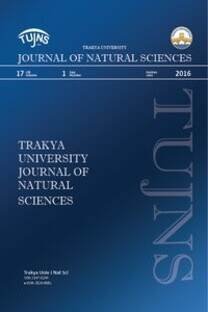Bazı şaraplık üzüm çeşitlerinin etkili sıcaklık toplamı gereksinimlerinin belirlenmesi ve bunun kalite özellikleri üzerindeki etkisi
Bu araştırma, Tekirdağ koşullarında dört şaraplık üzüm çeşidinin (Cinsaut, Kalecik Karası, Semillon ve Yapıncak) Etkili Sıcaklık Toplamı (EST) gereksinimlerini belirlemek amacıyla yapılmıştır. Bu amaçla iki yıllık (1998-1999) vejetasyon devresinde, gözlerin uyanması-tam çiçeklenme (I), tam çiçeklenme-ben düşme (II), ben düşme-hasat (III) ve gözlerin uyanması-hasat (IV) olmak üzere dört fenolojik dönem esas alınarak EST değerleri hesaplanmıştır. Çeşitlerde gözlerin uyanmasından tam çiçeklenmeye kadar geçen dönemde (I) EST'nin iki yıllık ortalama değerleri, Cinsaut çeşidinde 379.9 d-g, Kalecik Karası çeşidinde 378.6 d-g, Semillon çeşidinde 328.6 d-g ve Yapıncak çeşidinde 362.4 d-g bulunmuştur. Çeşit sırası esas alınarak bu değerler diğer dönemler için sırasıyla, II. dönemde: 817.1 d-g, 678.7 d-g, 705.6 d-g, 840 d-g, III. dönemde: 573.4 d-g, 688.3 d-g, 655.4 d-g, 674.1 d-g, IV. dönemde 1770.4 d-g, 1745.6 d-g, 1721.3 d-g, 1876.4 d-g bulunmuştur. Gözlerin uyanmasından hasada kadar geçen dönemde (IV) en yüksek EST değeri Yapıncak çeşidinde (1876.4 d-g) bulunmuş; bunu sırası ile Cinsaut (1770.4 d-g), Kalecik Karası (1745.6 d-g) ve Semillon (1721.3 d-g) çeşitleri izlemiştir.
Anahtar Kelimeler:
toplam kuru madde, çözünebilir katı madde, asitlik, çiçeklenme, vejetasyon, fenoloji, üzüm
Determination of heat summation requirements of some wine grape cultivars and its effect on quality characteristics
This research was carried out to determine the Heat Summation Requirments (HSR) of four wine grape cultivars (Cinsaut, Kalecik Karası, Semillon, Yapıncak). In two year of the vegetation period, by paying to attention to four phenological period of the cultivars such as from the bud bursting to full flowering (I), from the full flowering to veraison (II), from the verasion to harvest (III) and from the bud bursting to harvest (IV); values of the HS were calculated. From the bud bursting to full flowering, HS values of the two year average (1998-199) in cultivars were found as 379.9 d-d in Cinsaut cv., 378.6 d-d in Kalecik Karası cv., 328.6 d-d in Semillon cv. and 362.4 d-d Yapıncak cv. By paying to attention to cultivars rank, this values for the other periods were found as 817.1 d-d, 678.7 d-d, 705.6 d-d, 840 d-d ( for II. period); 573.4 d-d, 688.3 d-d, 655.4 d-d, 674.1 d-d (for III. period); 1770.4 d-d, 1745.6 d-d, 1721.3 d-d, 1876.4 d-d (for IV. period), respectively. From the bud bursting to harvest, the highest HS values was obtained from the Yapıncak cv. as 1876.4 d-d and it was followed by cv. Cinsaut (1770.4 d-d), cv. Kalecik Karası (1745 d-d) and cv. Semillon (1721.3 d-d), respectively.
Keywords:
total solids, soluble solids, acidity, flowering, vegetation, phenology, grapes,
___
- 1 ALISHEV, H.. Study of the Ecological Conditions in Southeast Bulgaria Regarding the Grapevine Development and Fruiting. Grad. I. Lazar. Naoka XIV (4):115-122, Sofia, 1977.
- 2 AMERINE, M.A. and WINKLER, A.J.. Composition and Quality of Must and Wines of California Grapes. Hilgardia, 15 : 493-675, 1944.
- 3 ÇELİK, H., MARASALI, B. ve DEMİR, İ. Ankara Koşullarında Ankara Koşullarında Yetiştirilen Sofralık ve Şaraplık Üzüm Çeşitlerinin Etkili Sıcaklık Toplamı İsteklerinin Belirlenmesi Üzerine Bir Araştırma. Türkiye III. Bağcılık Sempozyumu, 31 Mayıs-3 Haziran 1988, Bursa, 11 s., 1988.
- 4 ÇELİK, S. Bağcılık (Ampeloloji). Cilt-I, Anadolu Matbaa Ambalaj Sanayi ve Ticaret Limited Şirketi, 426 s.
- 5 DEMİRBÜKER, Y.,. Toprak ve İklim Özellikleri Yönünden Trakya Bölgesi Bağcılığı, XXIII. Dünya Meteoroloji Günü, Tarımsal Meteoroloji Semineri, 23-25 Mart 1983, Başbakanlık Devlet Met. Y. Gnl. Md., 138-159, 1983.
- 6 DÜZGÜNEŞ, O., KESİC,, T., KAVUNCU, O. ve GÜRBÜZ, F. Araştırma Deneme Metodları. Ankara Üniversitesi, Ziraat Fakültesi Yayınları :1021, Ders Kitabı No :295, 1987.
- 7 GALET, P. Precis de Viticulture, 4’e Edition, Rue de La Croix Lavit 34100, Montpellier, France, 584 p, 1983.
- 8 HUGLIN, P. Biologie et Ecologie de La Vigne, 4e Edition Payot Larusanne, Paris, 372 p, 1986.
- 9 JACKSON, D.I. and SCHUSTER, D. The Production of Grapes and Wine in Cool Climates. Butterworths of New Zealand, 205-207 p, Victoria Street Wellington, 1987.
- 10 JONES, V. G. and DAVIS, R.E. Climate Influence on Grapevine Phenology, Grape Composition and Wine Production and Quality for Bordeaux, France. American Journal of Viticulture, Vol. 51, No.3, 2000.
- 11 MCINTYRE, G.N., KLIEWER, W.M. and LIDER, L.A. Some Limitations of the Degree Day System as Used in Viticulture in California. Vitis, vol.27, no.1.
- 12 ORAMAN, M.N.. Bağcılık Tekniği II. Ankara Üniversitesi Ziraat Fakültesi,Yayın No: 470, Ders Kitabı: 162, 402 s, 1972.
- 13 PRESCOTT, J.A. The Climatology of the Vine (V. Vinifera L). A Comparasion of France and Australia on the Basis of the Temperature of the Warmest Month. Royal Society of S. Australia, 93:7-15, 1969.
- 14 REYNIER, A. Realisations Agrometeorologiques En Viticulture: Zonage Du Vignoble Turc, Vignes et Vines :53:56 p,1982.
- 15 TOMASI, D. and COSTACURTA, A. Aptitude of Some Bioclimatic Indices to Value the Enviromental Viticulture Potentiallity. Atti del Convegno Studio Ambienti Asti 14e 15 Luglio, 281-290 p, 1993.
- 16 WINKLER, A.J. Maturity of Table Grapes. The Relation of Heat Summation to Time of Maturing and Palatability. Amer. Proc. Hort. Sci. 21:295-298 p, 1948.
- 17 WINKLER, A.J., COOK, J.A., KLIWER, W.M. and LIDER, L.M. General Viticulture.University of California Press. Berkeley and Los Angeles, 710 p, 1974.
- ISSN: 1302-647X
- Yayın Aralığı: Yıllık
- Başlangıç: 2018
- Yayıncı: -
Sayıdaki Diğer Makaleler
Ankara Nallıhan örneğinde yaban hayatı envanteri
Air-borne particulate matter and its viable fraction during severe weather conditions in cairo,egypt
MURAT TÜRKYILMAZ, Tatman Müşerref OTKUN, Adilhan FEYİZOĞLU
Trakya Bölgesi'ndeki ticaret borsalarının genel yapısı ve özellikleri
